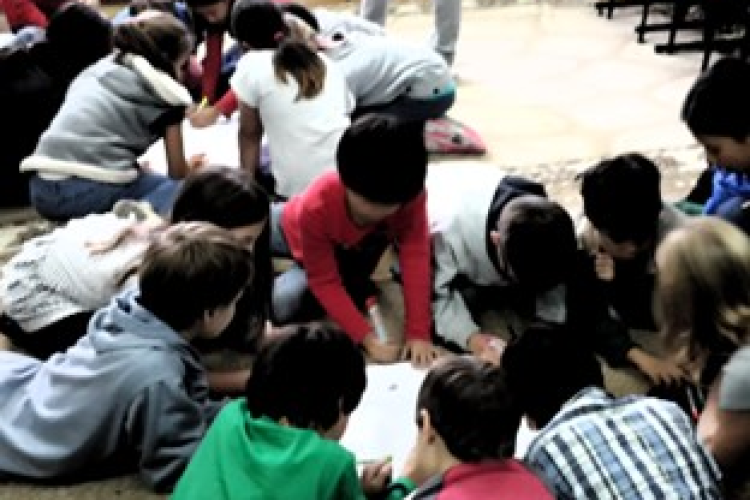Cultivating a Culture of Student Collaboration

Collaboration is the inevitable outflow of God’s image in us. The Trinity is a community, and as image-bearers of God, we mirror that reality. Family, friends, work, school, church, civic organizations – our lives are a network of interconnected relationships, often built around shared tasks, goals, or values. Students, no matter their age, are in the process of growing into their God-given identities, of which human community is a fundamental part.
What does this mean for a teacher thinking about “how to instill a culture of collaboration” into their classroom? Simple: you’re asking the wrong question. There’s already a culture there, whether you’re aware of it or not. It may not be what you want – but it is there.
This doesn’t mean that it isn’t important to reflect on how collaboration is woven into your classroom’s culture – far from it! But it does mean that we should be asking ourselves different questions about it. Namely, we should look to gain clarity on what culture we would like to see and what culture is already there. Only then can we work to bring the two into better alignment.
You can approach this reflection as a series of three different questions. Let’s take each of these in turn.
What do I want collaboration to look like in my classroom?
As with so much in education, you must start with your end goals in mind. It may seem like a no-brainer to say that you want “collaboration” in your classroom… but what do you actually mean by that? To take an extreme example: cheating is collaboration, right? Clearly, we’re not talking about promoting that!
It’s an interesting exercise to reflect on the fact that the same behavior can be “productive collaboration” in one context (a group project) and “illicit conduct” in another (taking a test). These may not be so easily distinguishable in the minds of your students, so explicitly talking about such realities can help you build trust and a culture of transparency with them. Doubly so if your students have a different home culture than you.
Knowing which forms of collaboration are important for your class and curriculum will help you understand how to promote a culture using them. For instance, which of the following forms of collaboration would you like to become “ingrained” in the cultural fabric of your class?
- Creating products – working together on projects, reports, slideshows, performances, etc.
- Refining products – students working together to improve each other’s work
- Preparing for assessments or performances – students partnering up to drill each other on various skills (preparing lines for a play, practicing for a sport, preparing for a math test, etc.)
- Discussing ideas – brainstorming and/or deepening understanding via multiple perspectives
- Checking for errors – students partnering up to ensure accuracy (especially in math and science)
- Performing experimentation – the most effective lab work is almost always collaborative
- Helping each other better understand concepts or skills – students re-explaining things
 in their own words for peers (often a student’s explanation can make more sense than the teacher’s)
in their own words for peers (often a student’s explanation can make more sense than the teacher’s) - Enjoying each other’s company – collaboration (in a culture of mutual respect) is engaging and fun
Each of these will require a different approach for introducing it into your class and fostering its use. While we can’t cover all of those approaches here, it’s important to know that such approaches do exist – and can be learned by teachers of all experience levels.
Be ready to explain the “why”
As with any classroom activity, having clarity on the “why” behind the assignment will help you better communicate its importance to your students. That, in turn, will go a long way towards helping them engage mindfully and enthusiastically with the task.
So… “why collaboration?” Besides being just plain fun and engaging, there are both Kingdom and academic purposes behind it.
Kingdom purposes: For our classrooms to be transformative spaces, we need to be mindful of, and intentional with, the role of classroom culture in providing a “glimpse of the Kingdom” to our students. 1 Corinthians 12 gives us a clear picture of how the Lord sees His Church ideally functioning in this world – and it is a picture of joyful, deep collaboration among very diverse people. When we work to build a culture of collaboration in our classrooms, we are helping our students live out a small piece of God’s intentions for them, right there in the school day!
Academic purposes: A lot of ink has been spilt in recent years about the importance of “21st century skills” -- specifically, the soft skills required by the workforce of this generation. In 2013, Google conducted an internal research study on their most successful employees and teams to identify the keys to their success. The surprising result? Skills associated with healthy collaboration were 3 of the top 7.
What does collaboration already look like in my classes?
It’s essential to take a clear-eyed look at what your classes actually look and feel like to a student. You may think your lessons are highly collaborative and engaging – but do the students agree? Do they feel like they are working together to perform a meaningful task… or are they dutifully performing yet another arbitrary assignment (just with a partner this time)?
Conversely, you might feel like your classes aren’t collaborative enough. That may be true – but you may also be surprised to find out that your students are engaging in study groups and deep discussions outside of your classroom.
The bottom line here is – take a clear-eyed look at your class from a student’s perspective, asking yourself whether the collaborative practices you want to cultivate are, in fact, taking root. Even better – ask a student or two what their experience of your class is.
How do I bring the reality of my class culture into alignment with my goals?
That’s a HUGE subject (too big for a single article) – but here are some pointers to get you started:
 Start with a Kingdom mindset and a clear vision of your classroom as a transformational space. Every task you assign, every seating chart, every class discussion is formative – it creates a picture of “what the Kingdom can look like” for your students. Take that seriously!
Start with a Kingdom mindset and a clear vision of your classroom as a transformational space. Every task you assign, every seating chart, every class discussion is formative – it creates a picture of “what the Kingdom can look like” for your students. Take that seriously!- Respect your limits and your students’ humanity. When you’re looking to affect culture (a set of beliefs and practices shared by a group), you only have so much scope in which to act. You can guide, model, intervene – but you cannot directly change a culture. It will be up to your students to respond positively (or not) to the picture you are trying to paint before them.
- Craft collaborative experiences with intentionality. Culture is emergent – but it can be guided. Think about how ethnic and national cultures are transmitted: shared stories, cultural liturgies, rites of passage… these are all intentionally crafted experiences. You can provide exactly the same thing for your students. Worksheet or paired discussion? There’s a collaborative choice that can be made there. Correct your own mistakes, or swap papers? Etc.
- Explicitly teach, model, and correct the behaviors you want to cultivate. (Especially at the start of the school year!) While you cannot force your students to behave in certain ways or value certain practices, you can promote them very heavily. In the first class of the year, cast a vision for the collaborative culture you want: “This class is one where you will be working with partners all the time.” “When I flick the lights, I want you to turn to your table partner and discuss how each of you would solve this problem,” etc.
NOTE: Make sure to follow through with what you say! If you want students quickly pivoting between whole class and paired discussions – model that! If you want students communicating respectfully with each other and asking probing questions, you must circulate through the classroom and listen to how they’re talking to each other. Don’t assume it will happen on its own – it won’t. You must intervene, quickly and often.
If someone says something unkind – or if they make a statement rather than asking a leading question – be there to immediately address it. Correct the behavior and model the desired behavior. 9 times out of 10, doing this consistently in the beginning of the year will bend the group’s culture towards something very close to what you want.
As a reminder: there’s a lot of good literature out there about promoting collaborative practices. If you’re interested in pursuing this more, reach out to a mentor teacher or contact School Services (school.services@teachbeyond.org) for more resources.
Finally, remember: be patient with yourself and your students!
We all want our classes to be oases of life and intellectual stimulation. Your class can be that! Yet, remember that every change in your practice is going to take some time to work out the kinks. You wouldn’t expect your students to master a new skill the first time they try it – remember to give yourself the same grace. The Lord certainly does!
Jesse Mercer
Jesse works with EducaVie (TeachBeyond France) and School Services as an associate member. He has been a counselor for at-risk youth, a youth pastor, a classroom educator (for 13 years), and is currently an instructional designer for an ed tech company in STEM-related subjects. He is passionate about helping educators lean into their God-given calling and extend their impact for His Kingdom.
Photo Credits
Photos by E Burnham. Adapted from original.



